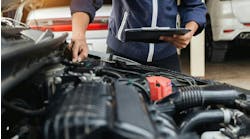The paint booth is arguably one of the most important tools in the collision repair paint department. While the spray booth first was developed to keep harmful overspray contained and away from other workers in the shop, it has evolved into a tool that protects workers and reduces environmental contamination, keeps work clean, and quickens application and curing, thus increasing shop production. Though a significant investment, a paint booth that's maintained properly and operated efficiently can produce 10 or more paint jobs a day.
When the filters in the booth are working properly, a technician may give little thought to them and how good a job they're doing. Proper filter maintenance, which ensures a quality finish and efficient operation, is a critical step to ensure the paint operation meets OSHA and NFPA health and safety standards and regulations. But filters that aren't maintained properly can cause fans to move less air and work harder. A scheduled filter check may help technicians develop the proper replacement schedule for filters.
The choices of paint booths for collision shops are vast. Booths are engineered to meet the needs and conditions of individual shops. Depending on the type of finish applied and production method, the booths, prestations (Fig 1) and edge-in-stations have been developed to meet various needs.
No matter which type of booth is used, a booth's manometer or magnehelic pressure gauge (Fig 2) should be checked daily. Or, if a booth isn't equipped with a meter, a scheduled change-out should be established relative to the amount and type of coating sprayed in the booth. If a prep station is used to spray primer fillers, the filters in that area might need to be changed more often than those in a booth that only sprays basecoat and clear. Primer filler is designed to fill, and what doesn't end up on the vehicle will fill the filters rapidly inste
Booth types
Booth technology has changed as paint has changed, and manufacturers have developed equipment to meet the needs. Some of the first booths used – when lacquer was the primary coating – were the crossdraft type (Fig 3), generally a simple noninsulated box that had filters on both ends. It worked by drawing air in from the rear and exhausting it at the front. These booths mainly worked to contain overspray and exhaust it to the outside. Lacquer paint dried mainly through evaporation, and a crossdraft booth helped quicken curing time, though evaporation time before the paint could be buffed (necessary with lacquer paint) was still generally 18 to 24 hours.
While crossdraft booths were a significant improvement compared to spraying vehicles in the open shop and performed the task they were principally designed for, they had significant problems protecting workers outside the spray area from overspray. They drew in massive amounts of air through the rear door, which, during the winter, could significantly lower the shop's temperature and tax the building's heating capability. They also drew massive amounts of air contaminated with shop debris across uncured paint, often depositing dirt as the filters became filled. While spray booths worked to remove harmful solvent vapors from inside the shop, most exhaust filters didn't remove these vapors or volatile organic compounds from the exhaust emitted into the air.
At this time, filter technology, drawing air through paper arresters (filters), was crude. The openings in these paper filters were an offset style, causing the air to change direction, thus depositing paint mist on paper as it passed by. Most paint fumes were exhausted out the paint stack, and as incoming air contaminated the rear booth filters quickly, it allowed most of the dirt and debris to pass through into the booth. All vehicles painted with lacquer were polished to create the desired shine, so small dirt particles were eliminated during the polishing.
The next type developed was the semidowndraft booth (Fig 4), in which air is drawn in from outside, heated as needed, and enters through the top at the rear, drawing it down over the vehicle and exhausting it out the front at or near the floor. These booths were an improvement over the simple crossdraft version because of their ability to heat air and not contaminate the vehicle with shop dirt.
Filter technology was changing also. Newer filters passed air through fiberglass that became progressively more finely textured, filtering out much more than paper arresters. Incoming air also was cleaned – prefiltered and passed through the ceiling filters, providing much cleaner air in the paint area. The air still traveled from the top rear, passing over the entire vehicle to be exhausted out the lower front. If any dirt got in or if there was a leak in the booth, dirt still was drawn over the vehicle, depositing it on fresh paint as it passed by.
At this time, booths were being equipped with fans that forced air into the booth and a second set of fans that drew out air. Because of the addition of a fan forcing air into the booths, the air flow could be adjusted by forcing in a slightly larger amount of air. Then the exhausting fan would draw it out, providing a positive air flow in the booths. If there was a leak in the booth, it would blow air out rather than sucking air and dirt in. Gauges that monitored air flow were installed on the booths that monitored air flow, which changed as filters became clogged. These air balance gauges helped painters maintain proper positive air flow in booths throughout the filter life.
The next generation of paint booths was the downdraft (Fig 5) group. These booths had incoming filters, which covered the ceiling, and exhaust filters in the floor that directed the air straight down, passing over a much smaller part of the vehicle. On some, the incoming air was prefiltered before it was passed on to the ceiling filter, which eliminated almost all the dirt and debris before it entered the booth. Through prefiltering, the incoming air ceiling filter, which had increased in efficiency to the point of eliminating particles as small as 7 microns (a micron equals one millionth of a meter), would last much longer. Filters in the floor, the first place paint is filtered, also became more efficient and could filter most of the dirt and paint particles before it passed into the exhaust filters.
With the increase of air filtration efficiency and air flow monitoring, it's more critical that painters control their booths more precisely and regularly. The introduction of basecoat/clearcoat paint decreased the need for polishing. Painters who wanted cleaner applications could no longer just wet down the floor before painting and expect to have a clean paint job. Booth maintenance was much more critical. Nowadays, painters often apply a removable covering on the floor (Fig 6) that can be swept between paint jobs and replaced quickly as needed when they become dirty. Removable wall covering, which traps any airborne dust particles that may be brought into the booth as the vehicle is loaded or unloaded, also is available. It, too, can be replaced as the covering becomes saturated with debris. These products help create a clean paint surface and help eliminate detailing after refinishing.
Many different filters
Filters come in many types and configurations and vary in price. They can be inefficient. Paper arresters or some fiberglass filters that trap only large particles and become clogged quickly are examples. Though denser filters cost more, they're more efficient and trap more particles, allowing them to last longer.
Prefilters and exhaust filters generally are made from a denser filter media and in a pillow configuration (Fig 7), which allows for a larger surface area, making it significantly more efficient.
Often, a more expensive filter may last much longer and do a better job of keeping the vehicle clean. Some have prefilters that remove coarse dust upstream of the ceiling diffusion filters, extending their life. These filters can remove 75 percent to more than 99 percent of particles measuring between 7 and 10 micrometers. This is necessary because the EPA regulations (http://www.epa.gov/fedrgstr/epa-air/2008/january/day-09/a24718.htm) that cover booth filters require they be able to filter 98 percent or greater of the hazardous air pollutants (HAP).
The national EPA standard requires all shops that spray coatings containing a targeted HAP conduct spray operations in a booth outfitted with an exhaust filter with a removal efficiency of 98 percent or greater. Shop owners should work with a spray booth manufacturer or filter supplier to select the right filter.
A painter might ask, "Should I change my filters monthly, every five paint jobs or when they look dirty?" The answer lies with the air balance meter (manometer or magnehelic pressure gauge, Fig 2).
As filters get clogged, the air flow through becomes more difficult. When this happens, the booth's balance changes. Eventually, the booth can no longer be balanced. A balance-control knob on the control panel is used to balance the booth in positive and negative directions. When the booth can no longer be balanced, filters should be checked. Start with the floor filters (Fig 8). If, after they've been changed, the booth won't balance, the exhaust and prefilters (Fig 9) should be checked. Ceiling filters (Fig 10) are changed less frequently but should be checked periodically. If all the filters have been changed except for the ceiling filter and the booth won't balance, the ceiling filter should be changed, too.
The EPA document "Spray Booth Filters: The Key to Quality Jobs and Clean Emissions" calls for ceiling filters to be changed twice a year and prefilters every month, although this depends on the amount and type of coating being sprayed. If the booth or prep deck isn't equipped with a flow meter, a handheld one could be used (Fig 11) to monitor the amount of airflow to determine when filters need to be changed.
Don't judge filters solely by how they look. Often, a fresh white filter in the floor will look dark and dirty after a black vehicle has been refinished. The precise amount of airflow should be checked from time to time. The booth's airflow should be almost the same at all four corners of the vehicle. Technicians should know the airflow of a loaded booth will be higher than the airflow of an empty booth. Knowing the exact amount of airflow is critical when waterborne paint is applied. A significantly higher amount of airflow is needed to evaporate waterborne basecoat than solvent-borne paints.
The regulatory landscape
When spraying waterborne basecoats, shops and technicians should stay informed about regulations in their geographic area. In the United States, some state and local jurisdictions are regulating automotive refinishing emissions. California and several northeastern states have developed practice standards for shops in certain districts to reduce VOC emissions. Canada also is requiring a switch to waterborne basecoats.
Keeping on top of the regulatory landscape can help shop owners decide if the time is right to switch to waterborne basecoats.
Conclusion
Though there are paint booth and prep filters regulations to abide by, scheduled filter maintenance does more than comply with EPA requirements. Filters clean the air before it enters the spray chamber. (Those in heavy industrial or agricultural areas know this well.) Clean air in a chamber helps keep vehicles clean and reduces the amount of needed detailing. Other precautions, such as removable floor and dirt-trapping wall coverings, make for a cleaner vehicle as it's painted. Then after the vehicle is sprayed, floor and exhaust filters clean the HAPs before exhausting the air into the environment. We have to do our part because the filters are only as good as their maintenance allows.


